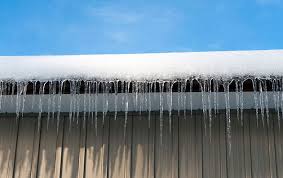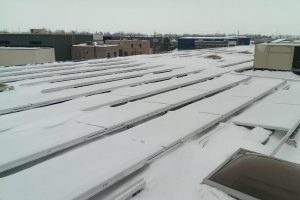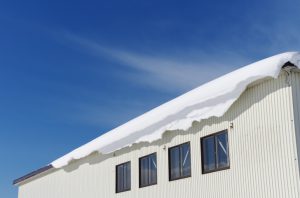
Winter Storms and Your Roof part 1
Heads Up!
From Lichtefeld Inc. and Butler Manufacturing
The winter season is here or fast approaching. While there is no way for Lichtefeld or Butler® to predict what this winter will bring, this bulletin is intended to assist you in helping our customers deal with severe or heavy snow storms that may occur.
 EXCESSIVE SNOW ACCUMULATION Heavy and/or repeated storms can create packed snow and ice such that only a few feet of depth may weigh 50 psf or more, imposing unusual and excessive loads on any building structure. Blowing and drifting snow can easily double these loads and rain on snow can also cause significant load increases. An excessive accumulation of snow can cause a building to be loaded beyond design capacity creating a risk of building damage or even collapse.
EXCESSIVE SNOW ACCUMULATION Heavy and/or repeated storms can create packed snow and ice such that only a few feet of depth may weigh 50 psf or more, imposing unusual and excessive loads on any building structure. Blowing and drifting snow can easily double these loads and rain on snow can also cause significant load increases. An excessive accumulation of snow can cause a building to be loaded beyond design capacity creating a risk of building damage or even collapse.
 What TO LOOK FOR Most snow related losses occur at stepped elevations where blowing snow is carried from the roof of a higher building onto the roof of a lower building. Such drifting normally occurs where the buildings are attached. However, drift loads can also form on closely adjacent buildings, over ridges, at valley conditions, behind parapets, next to rooftop units, and on below eave canopies or overhangs. Post construction changes to the building site, added higher buildings or significant tree growth can also cause drifting where none was anticipated. Modifications to the structure, loads added after the original design (such as piping, roof units, hanging heaters, etc.) and prior damage to the structure are other areas of particular concern because they may have significantly reduced the capacity of the building to withstand snow loads.
What TO LOOK FOR Most snow related losses occur at stepped elevations where blowing snow is carried from the roof of a higher building onto the roof of a lower building. Such drifting normally occurs where the buildings are attached. However, drift loads can also form on closely adjacent buildings, over ridges, at valley conditions, behind parapets, next to rooftop units, and on below eave canopies or overhangs. Post construction changes to the building site, added higher buildings or significant tree growth can also cause drifting where none was anticipated. Modifications to the structure, loads added after the original design (such as piping, roof units, hanging heaters, etc.) and prior damage to the structure are other areas of particular concern because they may have significantly reduced the capacity of the building to withstand snow loads.
WHAT TO DO We recommend that you are aware of the damages which can occur when excessive snow accumulation is present. Much of the public is unaware of the consequences of allowing snow buildup on their roofs. However, many property insurers are beginning to provide their insureds with information on what to do in the event of a snow emergency, such as advising building owners to activate a snow watch and removal crew to monitor snow depths and to remove excessive accumulations of snow from the roofs. Additional warnings from you may help prevent significant damage from occurring. Building owners should also be advised to keep drains and gutters clear of ice and snow to facilitate melting run-off. Ice and snow buildup can cause excessive loads even without drifts. Heat tapes in gutters and downspouts may assist in preventing ice build-up, except during extremely low temperatures. Building owners should also be aware of warning signs inside the building that may indicate excessive snow accumulation, including the deflection of purlins, the popping out or bowing of ceiling tiles in dropped ceilings, and unusual noises. If any of these situations occur, the building owner should be advised to contact Lichtefeld, Inc immediately for assistance. As a preventative measure, when placing an order, always be sure that Butler is fully advised of any conditions that may potentially cause an accumulation of snow, such as stepped elevations, closely adjacent buildings, ridges and valleys, parapets, roof top units, below eave canopies, and the like.
SUGGEST IONS ON HOW TO DEAL WITH A ROOF NEAR COLLAPSING – Personnel safety is of utmost concern both during the shoring operation and during snow removal. Adequate precautions must be taken. If a roof is in danger of collapsing, the building should be immediately evacuated and the following emergency procedures are recommended:
IONS ON HOW TO DEAL WITH A ROOF NEAR COLLAPSING – Personnel safety is of utmost concern both during the shoring operation and during snow removal. Adequate precautions must be taken. If a roof is in danger of collapsing, the building should be immediately evacuated and the following emergency procedures are recommended:
1. In many situations, the most effective solution is shoring of the purlins. In most large cities, commercial shoring service is available. If not, timbers may be used.
2. In some cases, removing snow build-up may be sufficient. See the back of this page for detailed snow removal information.
3. Large industrial heaters inside the building may also assist in melting snow and ice from the roof. IN CASE OF COLLAPSE In case of a roof collapse, mitigation of loss should be the first priority. Damage to contents is a major item and prompt snow removal is imperative. Once the snow is removed, the next step is construction of temporary cover to keep the weather out and allow clean-up to begin. Documenting the snow loads and resulting damage is also essential. For your reference, part two of this page contains a procedure Lichtefeld and Butler uses in these situations. Be sure and call us, our assistance in gathering this information will be most helpful. Fast response by you in these emergency situations can help you get back into business quickly. Lichtefeld and Butler Manufacturing stands ready to work with you in these situations. Check out part two concerning snow and ice removal later on this blog.
